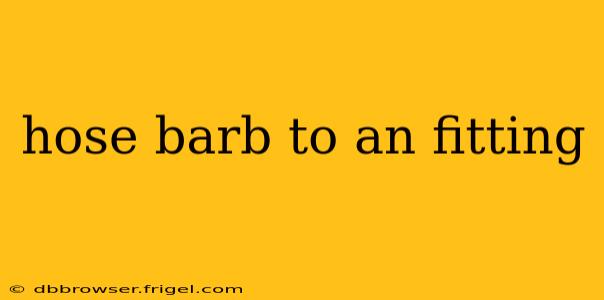Connecting a hose barb to a fitting is a common task in various applications, from plumbing and irrigation to automotive and industrial settings. While seemingly straightforward, understanding the correct methods and choosing the right components ensures a secure, leak-free connection. This guide will walk you through the process, addressing common questions and potential issues.
What is a Hose Barb?
A hose barb is a short, cylindrical fitting with a series of ridges or barbs on its outer surface. These barbs grip the inner wall of a hose when the hose is clamped onto the barb. This creates a secure connection that resists pressure and prevents leaks. Hose barbs are typically made of metal (brass, stainless steel) or plastic.
What Types of Fittings are Compatible with Hose Barbs?
Hose barbs are designed to connect to a variety of fittings, depending on the application and material. Common compatible fittings include:
- Compression Fittings: These fittings use a compression nut and ferrule to create a leak-proof seal on the hose.
- Push-to-Connect Fittings: These fittings require simply pushing the hose onto the barb; no additional tools or clamps are needed. However, these are usually suitable for lower pressure applications.
- Clamped Fittings: These fittings require a hose clamp to secure the hose onto the barb, offering a secure and reliable connection, especially for higher pressure applications.
How to Connect a Hose Barb to a Fitting Using a Clamp?
This method provides the most secure connection and is ideal for high-pressure applications.
Tools Required:
- Appropriate hose clamp (choose one that fits the hose diameter snugly)
- Screwdriver (or other tool depending on the clamp type)
Steps:
- Prepare the Hose: Ensure the hose end is clean and free of debris. A slight chamfer on the hose end can help with insertion.
- Insert the Hose: Carefully push the hose onto the hose barb until it's seated firmly against the shoulder of the fitting.
- Secure with Clamp: Position the hose clamp around the hose and barb, ensuring it's evenly distributed. Tighten the clamp securely using the appropriate tool. Do not overtighten, as this could damage the hose.
What Size Hose Clamp Should I Use?
The correct hose clamp size is crucial for a secure and leak-free connection. The clamp should be appropriately sized for the hose's outer diameter. Always refer to the manufacturer's instructions for your specific hose and clamp. Using a clamp too small will fail to create a proper seal, and too large will allow slippage.
How to Connect a Hose Barb to a Push-to-Connect Fitting?
Push-to-connect fittings offer a quick and easy connection solution, but are often best suited for lower pressure applications. Simply push the hose onto the barb until it clicks into place. Always verify the connection's security and check for leaks after installation.
What are the Potential Problems When Connecting a Hose Barb to a Fitting?
- Leaks: This is the most common problem and is usually due to improper clamping, incorrect hose size, a damaged hose or barb, or debris in the connection.
- Hose Damage: Over-tightening the clamp can damage the hose, leading to leaks or failure.
- Incorrect Fitting: Using an incompatible fitting can result in a weak or leaky connection.
How Do I Fix a Leaky Hose Barb Connection?
First, identify the source of the leak. It could be a poorly tightened clamp, a damaged hose or barb, or an incorrect fitting. If the clamp is the problem, retighten it (but avoid overtightening). If the hose or barb is damaged, replace the affected component. If the issue persists, re-evaluate the fitting type and ensure compatibility.
By following these steps and paying attention to detail, you can ensure a secure and reliable connection between your hose barb and fitting. Remember to always consult the manufacturer's instructions for your specific components for the best results and to avoid potential issues.
